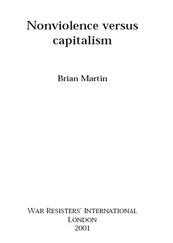In earlier eras, it was possible to imagine that military technologies could be a source of liberation as well as oppression. The sword and the rifle can be used not only by rulers but also against them. [5] . Even if armed liberation is possible, it may not be a promising road to a better society, since it involves killing, secrecy, centralisation of power and male domination. The armed liberators often become the new oppressors.
But it is difficult to imagine cluster bombs and nuclear weapons being used for popular liberation. Modern weapons are mainly of use by governments against peoples, often against their own populations.
What is the alternative to military science and technology? The most common response of the world’s governments is to seek controls, such as treaties against biological weapons or agreements on numbers of nuclear missiles. Such reforms are welcome enough but do little or nothing to stem the development of ever more sophisticated weapons. Indeed, some critics argue that arms control negotiations serve only to regularise military races, not to halt them. [6] . Johan Galtung, “Why do disarmament negotiations fail?” Gandhi Marg , nos. 38-39, May-June 1982, pp. 298-307; Johan Galtung, There Are Alternatives! Four Roads to Peace and Security (Nottingham: Spokesman, 1984), pp. 131-138; Alva Myrdal, The Game of Disarmament: How the United States and Russia Run the Arms Race (New York: Pantheon, 1976). Among other factors, disarmament negotiations keep control over the agenda in the hands of the dominant governments and dampen public concern by giving the illusion that something is being done about the problem.
Whereas most governments seek only those limited controls on weapons to which they agree, peace movements around the world have called for disarmament and totally getting rid of certain types of weapons, particularly nuclear, biological, chemical and antipersonnel weapons. Some groups and movements have pushed for complete elimination of weapons and armies. Peace movement campaigns have had some obvious successes, such as the banning of above-ground tests of nuclear weapons, and also have created a climate of opinion that has sometimes held back aggressive governments. However, peace movement campaigns have seldom dealt directly with the complex of scientific and technological operations serving military ends.
One exception to this is the movement for “peace conversion” or “economic conversion.” [7] . See, for example, Bonn International Center for Conversion, Conversion Survey 1996: Global Disarmament, Demilitarization and Demobilization (Oxford: Oxford University Press, 1996); Seymour Melman, The Demilitarized Society: Disarmament and Conversion (Montreal: Harvest House, 1988); Judith Reppy (ed.), Conversion of Military R&D (Basingstoke: Macmillan, 1998); Peter Southwood, Disarming Military Industries: Turning an Outbreak of Peace into an Enduring Legacy (Houndmills, Basingstoke: Macmillan, 1991); and the journal Positive Alternatives , published by the Center for Economic Conversion, 222 View Street, Mountain View CA 94041-1344, USA.
What this means is converting science, technology and industry from military purposes to civilian purposes, especially to activities that serve human needs. This might mean converting a gun factory to a home appliance factory or shifting from research into missile ballistics to research into public transport. Historically, this sort of conversion was routine at the ends of major wars. But as military technology becomes ever more specialised, conversion to civilian purposes becomes more difficult. Converting production from military trucks to civilian trucks is not so difficult; converting production from nuclear submarines to a useful civilian technology is quite a challenge. The technological dimension to peace conversion is actually the smaller hurdle. The major obstacle is the political and economic interests in continuing military production. These interests have become entrenched since World War II, so that governments administer what can be called a “permanent war economy.”
Peace conversion is a vital part of any process of changing science and technology so that they no longer serve to sustain war and repression. But peace conversion can be only one part of this process, since it provides no alternative means of directly providing the security that is the stated rationale for, if seldom the consequence of, military forces. (The deeper driving forces behind military systems are discussed in chapter 2.)
One alternative to the military is nonviolent defence. The military option involves professional soldiers using specially designed instruments of violence to defend and attack. Nonviolent defence involves all concerned people using methods of nonviolent action such as rallies, refusals to obey, strikes, boycotts, sit-ins and setting up alternative institutions. As a full alternative to military forces, nonviolent defence is also called social defence, civilian defence, civilian-based defence and defence by civil resistance. From a nonviolence viewpoint, only some functions of the military — notably defending the core values of a society against attack — need to have a nonviolent replacement. A nonviolent defence system would not take up other functions of militaries, such as internal repression and threatening other societies.
Methods of nonviolent action can also be used in campaigns against oppression, such as the independence movement in India led by Mohandas Gandhi and the US civil rights movement led by Martin Luther King, Jr. There are numerous other examples, some of which are described later.
For those who are accustomed to thinking about weapons systems or to hearing about horrific wars and massacres around the world, nonviolent action at first glance may seem woefully inadequate. Actually, though, it can be an incredibly powerful technique. The key to nonviolent action is promoting refusal to consent. Even the most powerful weapons system requires human decisions to build, maintain and operate it. If manufacturers, commanders or operators refuse to cooperate, weapons will not be created or used. There are many examples where this process has occurred.
Most studies of nonviolent action have focussed on social and psychological factors, such as how to mobilise support. This is appropriate, since social and psychological factors are the keys to successful nonviolent struggle. Nevertheless, there is a role for technology appropriate for nonviolent defence. That is the theme of this book.
Consider the vast resources, both human and material, that have been devoted to military purposes for many decades. This includes development of weapons systems, training of large armies, military exercises, military industries, and orientation of social institutions to military ends. By comparison, only a tiny effort has been made to improve methods of nonviolent struggle. Is it any wonder that nonviolent defence is not a well-developed alternative? Its occasional successes are all the more remarkable, considering that they are analogous to the success of an army that had no weapons production, no training, no money and no planning. The implication of this comparison is that nonviolent defence should not be dismissed until it has been investigated, supported and tested on a scale similar to military defence.
In the next chapter, the connections between technology and the military are analysed. Chapter 3 gives a brief introduction to the dynamics of nonviolent action. Chapter 4 introduces the main subject: how technology might be used to support nonviolent struggle.
Nonviolent struggle potentially can involve nearly any area one can imagine, from sculpture to soccer. Since technology is increasingly pervasive, this means that design and choice of technology for nonviolent struggle also potentially affects nearly any conceivable area. In many areas, it seems, no one has even begun to think through the implications. Chapters 5 to 8 give special attention to the key areas of communication, survival, the built environment and countering attack. Other areas that might be examined include art, sport, policing, prisons, money and jobs. [8] . On the topics of policing, prisons and economics from the perspective of social defence, see Brian Martin, Social Defence, Social Change (London: Freedom Press, 1993).
Chapter 9 discusses the implications of nonviolent action for methods of doing research. Chapter 10 addresses the issue of “policy”: how to move from present-day militarised technology to a technology useful for nonviolent struggle.
Читать дальше












